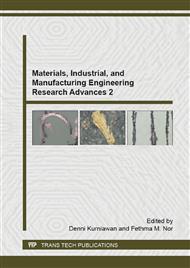[1]
E. Santos, N.K. Kuromoto, and G.A. Soares, Mechanical properties of titania films used as biomaterials, Mater. Chem. & Phys. (2006).
Google Scholar
[2]
P. Kern, P. Schwaller, and J. Michler, Electrolytic deposition of titania films as interference coatings on biomedical implants: microstructure, chemistry and nano-mechanical properties, Thin Solid Films, 494 (2006) 279 – 286.
DOI: 10.1016/j.tsf.2005.09.068
Google Scholar
[3]
H. Ishizawa and M. Ogino, Formation and characterization of anodic titanium oxide films containing Ca and P, Biomed. Mater. R., Vol 29 (1995) 65 – 72.
DOI: 10.1002/jbm.820290110
Google Scholar
[4]
X. Liu, P.K. Chu, and C. Ding, Surface modification of titanium, titanium alloys, and related materials for biomedical applications, Mater. Sci, & Eng. R., Vol 47 (2004), p.74.
Google Scholar
[5]
M. Keshmiri and T. Troczynski, Apatite Formation on TiO2 Anatase Microspheres, Non-Crystalline Solids, 324 (2003), 289-294.
DOI: 10.1016/s0022-3093(03)00363-6
Google Scholar
[6]
F.J. Gil, A. Padros, J.M. Manero, C. Aparicio, M. Nilsson, and J. A Planell, Growth of bioactive surfaces on titanium and its alloys for orthopaedic and dental implants, Mater. Sci. & Eng. C, 22 (2002) 53 – 60.
DOI: 10.1016/s0928-4931(01)00389-7
Google Scholar
[7]
H.J. Oh, J.H. Lee, Y. Jeong, Y.J. Kim, and C.S. Chi, Microstructural characterization of biomedical titanium oxide film fabricated by electrochemical method, Surf. & Coating Tech., 198 (2005) 247 -252.
DOI: 10.1016/j.surfcoat.2004.10.029
Google Scholar
[8]
X. Bokhimi, A. Morales, M. Agilar, J.A. Toledo-Antonia, and F. Pedraza, Local order in titania polymorphs, Int. J. of Hydrogen Energy, Vol 26 (2001), p.1279.
DOI: 10.1016/s0360-3199(01)00063-5
Google Scholar
[9]
Y. Han, S.H. Hong, and K.W. Xu, Porous nanocrystalline titania films by plasma electrolytic oxidation, Surf. & Coating Tech., 154 (2002) 314 – 318.
DOI: 10.1016/s0257-8972(02)00036-1
Google Scholar
[10]
X. Cui, H.M. Kim, M. Kawashita, L. Wang, T. Xiong, T. Kokubo, and T. Nakamura, Preparation of bioactive titania films on titanium metal via anodic oxidation, Dental Materials, 25 (2009), 80-86.
DOI: 10.1016/j.dental.2008.04.012
Google Scholar
[11]
H.Z. Abdullah, P. Koshy, and C.C. Sorrell, Anodic oxidation of titanium in mixture of β-glycerophosphate (β-GP) and calcium acetate (CA), Key Eng. Mater, Vols 594-595 (2014), p.275.
DOI: 10.4028/www.scientific.net/kem.594-595.275
Google Scholar
[12]
B. Yang, M. Uchida, H.M. Kim, X. Zhang, and T. Kokubo, Preparation of bioactive titanium via anodic oxidation treatment, Biomater., 25 (2004) 1003 – 1010.
DOI: 10.1016/s0142-9612(03)00626-4
Google Scholar
[13]
M.P. Casaletto, G.M. Ingo, S. Kaciulis, G. Mattogno,L. Pandolfi, and G. Cavia, Surface studies of in vitro biocompatibility of titanium oxide coatings, Applied Surf. Sci., 172 (2001) 167-177.
DOI: 10.1016/s0169-4332(00)00844-8
Google Scholar
[14]
T. Kasuga, H. Kondo, and M. Nogami, Apatite formation on TiO2 in simulated body fluid, J. of Cryst. Growth, 235 (2002) 235 – 240.
DOI: 10.1016/s0022-0248(01)01782-1
Google Scholar
[15]
H.Z. Abdullah, L.T. Chuan, M.I. Idris, and C.C. Sorrell, Effect of Current Density on Anodised Titanium in Mixture β-Glycerophosphate (β-GP) and Calcium Acetate (CA), Adv. Mater. Res., In press.
DOI: 10.4028/www.scientific.net/amr.1087.212
Google Scholar
[16]
L.T. Chuan, M.I. Idris, H.Z. Abdullah, and C.C. Sorrell, Effect of Electrolyte Concentration on Anodised Titanium in Mixture β-Glycerophosphate (β-GP) and Calcium Acetate (CA), Adv. Mater. Res., In press.
DOI: 10.4028/www.scientific.net/amr.1087.116
Google Scholar
[17]
M.A. Selimin, N.H.M. Idrus, and H.Z. Abdullah, Anodic Oxidation of Titanium for Biomedical Application, Adv. Mater. Res., In press.
Google Scholar


